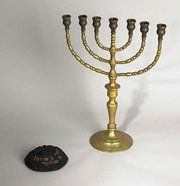Menorah
|
|
A menorah (sometimes capitalized) is a branched candelabrum with seven candle-holders. It is displayed in Jewish synagogues. The menorah was the ancient representation of the Hebrews and is one of the oldest symbols of the Jewish people. It symbolises the burning bush as seen by Moses on Mount Sinai. The two most common menorahs have seven and nine candle-holders. The term hanukiah or chanukiah, refers to the nine-candled holder used during Hanukkah. This term was coined in Israel during the 20th century when Hebrew was growing after being mostly dormant as a street language for centuries.
Coin_issued_by_Mattathias_Antigonus_c_40BCE.jpg
The original design for the seven-candle menorah is in the Torah. The menorah originally burned olive oil, not candles. The menorah was used in rituals in the tabernacle (portable sanctuary) and later the Holy Temple in Jerusalem. Since the destruction of the Temple, the menorah has had no formal role in Jewish prayer services or rituals. The presence of a menorah in some synagogues is purely symbolic. Some synagogues today use a lamp-stand called the "ner tamid" to symbolize the menorah.
The nine-candle menorah is used to celebrate the Jewish festival of Hanukkah. Hanukkah originally celebrated the Maccabees' defeat of the superior Syrian army. However, post-biblical Jewish tradition as recorded in the Talmud describes that when the Maccabees were rededicating the Temple, they only found enough oil to light the menorah for one day. A miracle occurred and the oil lasted for eight days. To celebrate Hanukkah, one candle is lit on the first night, two candles are lit on the second night, and so on. The ninth candle, the "shammes" (in Yiddish) or "shamash" (in Hebrew), is a "helper candle" that is used to light the others, and to provide light, since tradition holds that one could not use the Hanukkah lights to illuminate one's home.
The fate of the original Menorah is obscure. A depiction is still available on the Arch of Titus that still stands today in Rome.
Sack_of_jerusalem.JPG
Depiction of the Menorah on the Arch of Titus
It remained in Rome until its sack by the Vandals in 455 A.D., but the Byzantine army under General Belisarius took it back in the 6th century and brought it to Constantinople. Here, the trail ends. It is not further mentioned in any Byzantine chronicles, and one can only speculate whether it remained there until the city was sacked or was brought back to Jerusalem. Another theory is that the Menorah was melted down during the Byzantine iconoclasm, a period during which most of the 3-dimensional religious icons of the empire were destroyed.
Template:JewishLifeCyclede:Menora fr:Menorah ko:메노라 pl:Godło Izraela

